Family : Delphinidae

Text © DrSc Giuliano Russini – Biologist Zoologist

English translation by Mario Beltramini
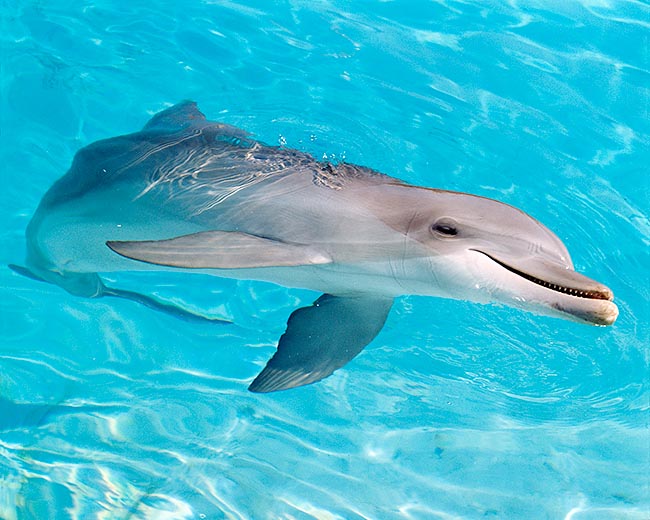
Like all cetaceans and unlike fishes, dolphin’s caudal fin develops horizontally © Giuseppe Mazza
The Common bottlenose dolphin or the Atlantic bottlenose dolphin (Tursiops truncatus Montagu 1821), is an aquatic plancetate mammal, afferent to the order of the Cetaceans (Cetacea), suborder Odontocetes (Odontoceta), family of the Delphinids (Delphinidae).
Tursiops truncatus has been considered for long time as the only species of the genus Tursiops, even if several authors have highlighted during the years some regional peculiarities. They have also described some subspecies recognizable through morphological differences and in the proportions of the appendices, and some biologists have advanced the hypothesis that they might be raised to the rank of species. Only molecular analyses have finally allowed the reckoning of at least two more species: Tursiops aduncus Ehrenberg 1833, typical of the warm seas of the Western Pacific, and Tursiops australis – Charlton-Robb et al. 2011, as the name suggests, frequent along the Australian coasts.
In English, the common name is bottlenose dolphin, in French, grand dauphin, in Spanish torsion and in Italian, tursiope or delfino dal naso a bottiglia. The meaning of the scientific name Tursiops truncatus is animal similar to the dolphin for “Tursiops” and with short rostrum for “truncatus”.
Zoogeography
This marine mammal is present from the cold temperate and subtropical waters up to the tropical ones of all the seas.
Habitat-Ecology
It is a mainly coastal species living in neritic waters; the neritic water, or neritic zone, corresponds, in the classification of the sea waters, to that zone going from the coast up to the end of the continental shelf, that goes up to the 200 metres of depth, receiving almost all the sunlight hitting the oceans and the seas. Presently the accepted are three, Tursiops truncatus, Tursiops aduncus and Tursiops australis. Among the described subspecies in various regions we remind: Tursiops truncatus gillii (north-eastern Pacific), Tursiops truncatus ponticus (Black Sea), Tursiops truncatus gephyreus (south-western Atlantic), Tursiops truncatus nuuanu (eastern Pacific). We cannot exclude that a closer study of these populations may lead to the definition of new species of the genus Tursiops.
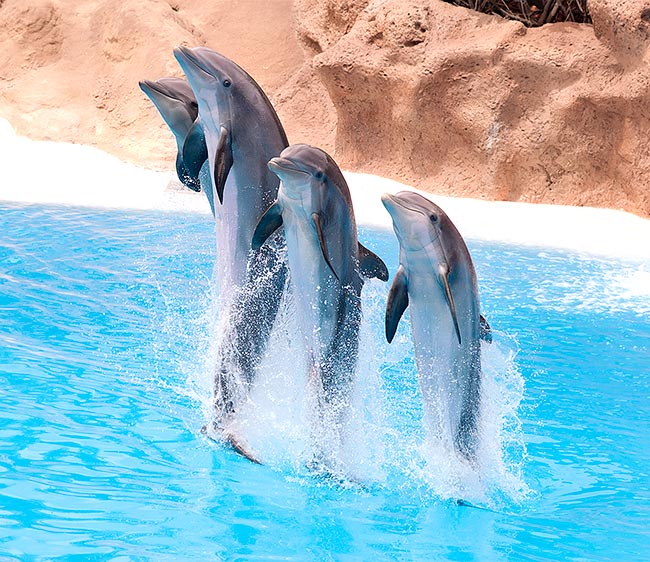
Present in almost all seas up to tropics, Tursiops truncatus can be 4 m long © Giuseppe Mazza
Though the International Union for Control of Nature (IUCN) identifies it status as of minimal risk “LC”, we must not drop our guard, because this most sweet and very nice animal, so much empathic towards the human being, as well as most intelligent, is actively hunted in the Philippines waters for food use and for making baits in fishing the Nautilus.
Amongst all delphinids species, it is the one best adapting to captivity and for this reason all dolphinaria and aquatic parks of the world exhibit this species which, due to its typical intelligence and agility, is involved in high acrobatics shows.
The International Whaling Commission (IWC), the official organization responsible for monitoring and prohibiting the regular and poaching hunting of the cetaceans, following to an indication gotten from its own internal scientific commission, has decided to review (and this is still under study), the systematics of the genus (Tursiops).
Morpho-physiology
This species is 4 metres long, with a maximum weight of about 670 kg. Its lifespan is of about 30 years.
Like the other cetaceans, the pisciform shape of these animals helps their hydrodynamics; among all delphinids, the common bottlenose dolphin is probably the fastest one, as it reaches the cruising speed of 50 km/h. Seemingly smooth, the skin of this dolphin is covered by several micro wrinkles which improve the swimming efficiency avoiding turbulence phenomena and helping the efficiency of the propulsive thrust of the powerful caudal fin. The streamlined body is rightly followed by a caudal fin whose appendage develops horizontally, instead of vertically, like in the true and real fishes; the powerful musculature of the caudal fin is compressed laterally, in order to offer, also in this case, the least resistance to the water and to give the greatest support to the caudal fin.
And this is why the cetaceans in general and therefore the dolphin too, swim moving the rear part of the body dorso-ventrally. The rather big dimensions of the dolphins or of the odontocetes in general, even if minor than most of the mysticites, are, along with the presence of a very thick adipose subcutaneous layer, an eco-evolutive adaptation, whose final aim stands in the minor dispersion of body heat.
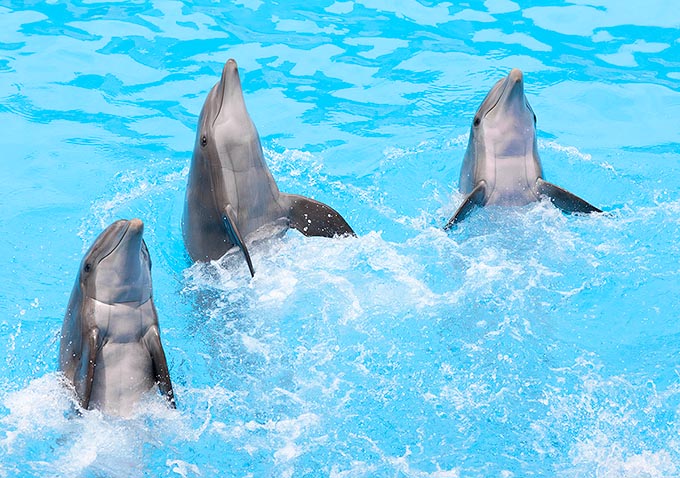
It frequents the coasts and its special crystalline allows good vision out and inside water © Giuseppe Mazza
As water is an excellent heat conductor and, as the internal temperature of a warm-blooded animal, such as rightly a mammal, is usually greater than that of the environment (in this case the sea water) where it lives and as, due to the Clausius law the heat moves from a warmer body towards a colder one, there should be thermal dispersion; as, due to the bio-geographic Allen-Bergmann’s principle, “the larger bodies do have a body surface and therefore a heat dispersion way lesser than that of smaller bodies”, the whole has evolutionally resulted in a rather important body dimension in order to get more stabilized and better adapted conditions of life.
Like all mammals, the breathing takes place by means of lungs, whereby cyclically after a certain time of apnoea whose duration varies depending on the species, (in the common bottlenose dolphin it lasts 8 minutes about), the dolphin gets back to the surface for breathing and storing the air supply.
All this happens by means of an opening called “spiracle” or “blowhole”, a single hole on the surface of the head (the whales do have two of them, lateral), corresponding to our nostrils. It comes probably, due to migration in such position, from the nostrils of a primitive terrestrial ancestor, perhaps a feline, as adaptation to the aquatic life.
The cetaceans begin to breathe out before surfacing, in way to be able to start the inspiration phase in the short time when the head keeps out of the water. Furthermore, the spiracle is abundantly innervated by terminations and is equipped with mechanoreceptors which allow its opening and closing, in synchrony with the emersion and the diving.
The fins of the dolphin (as well as for all cetaceans) are of three types, the whole of these resemblances and differences with the fishes, renders it a sort of biological paradox. The pectoral and dorsal fins direct and stabilize the swimming, the caudal fin gives the impulse to the movement.
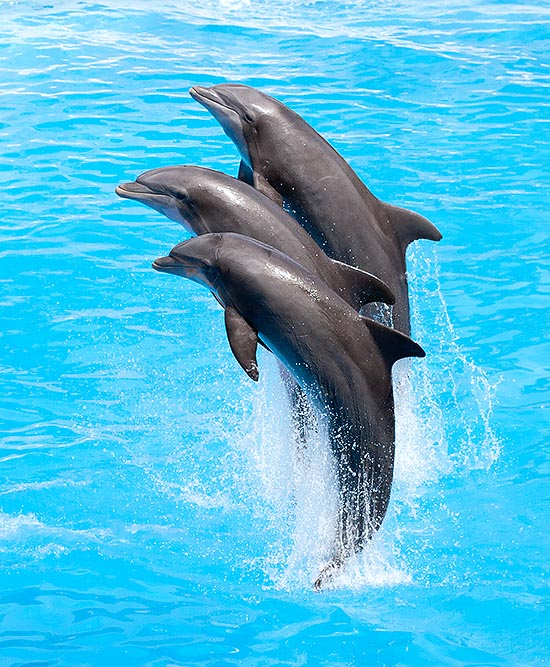
It’s the fastest dolphin, able to reach 50 km/h with showy leaps © Giuseppe Mazza
From the terrestrial tetrapods, they keep only the forelimbs (the X-ray of a dolphin’s fore fin shows us a disposition of the bines really resembling to the hand of a mammal) and the pectoral girdle whose structure consists in a scapula, a humerus, a radius, the ulna, the carpus, the metacarpus and the phalanges, the typical osseous chain of a terrestrial mammal.
The hindquarters are only vestigial rudiments which abort during the embryonic development with respect to all other subaerial mammals. In the males, these vestiges are connected with the pelvic muscles of the reproductive system. The dorsal and caudal fins do not have skeleton; their rigidity is due to a thickly intricate tissue of connective fibres.
The fins have a role also in the thermoregulation avoiding the overheating phenomena: a dolphin under stress is subject to an increase of the body temperature, with this also the blood pressure increases and this activates a peripheral circulation at the level of the fins, richly perfused. Here, through thermal countercurrent exchanges, the heat in excess carried by the arterial blood is passed to the venous component of the circulation, which will then cede it by dilation to the water; a similar phenomenon is found in the enormous pinnae of the African elephant (please see text Proboscidea).
The cetaceans have an eye similar to that of the ungulates, the curvature of the lens has the capacity of modifying to adapt the focusing; this allows them to see well inside the water as well as out from the same. However, seen that the conditions of the water are not always clear and seen that some dolphins are river species, where the water is usually turbid, the eyesight is not the most utilized sense for the research of food or for escaping a predator.
This leads us to talk about a physiologic and biophysical capacity present in the dolphins (but also in other cetaceans and mammals, such as the bats), which is the most original characteristic of this animal, the so-called “biosonar”, or “echolocation” device.
Since many years, the biologists know well, thanks to studies of bioacoustics and recordings done by means of hydrophones, that the dolphins, like all other cetaceans, emit continuously sound of various nature and in various sequences, which they utilize for keeping the social contacts as well as language, for expressing a behaviour status but also for sounding the bottom in order to avoid an obstacle (a rick), along their way or for seizing a prey, a fish or a squid, or for escaping a predator, for instance a killer whale or a shark.
The odd thing is that the dolphins as well as the whales (which use the biosonar), do not have vocal cords. The assumptions made on how these sounds are emitted have been numerous and still now their mechanism has not been completely explained by the biologists, but, in a very general line, it s thought that they are produced by a volume of air emitted by the lungs at high pressure, which, ascending on internal ways, reaches an adipose structure, the “melon”, located in the front of the dolphin, where they are amplified and emitted with a variable frequency; the other hypothesis is, on the contrary, that the sounds produced by the moving mass of air coming from the lungs, generate from the vibration of the cartilage of the epiglottis with the larynx the acoustic centre, whilst the melon should be a reception organ.
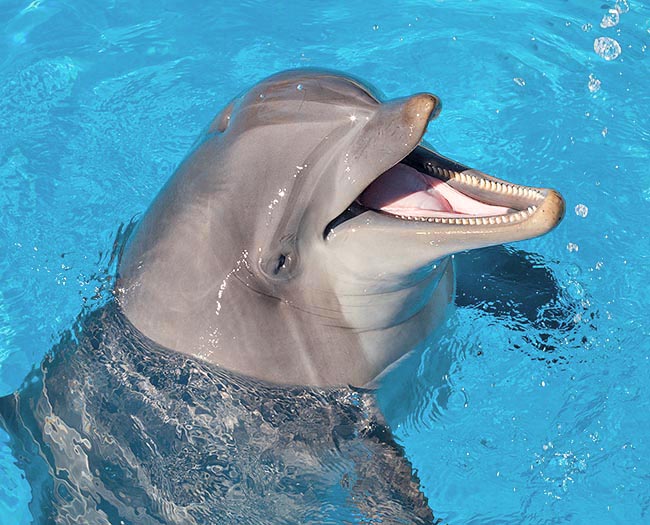
A complex biosonar enables preys or dangers location and mutual communications © Giuseppe Mazza
However, whatever is the mechanism at the base of such a wonderful means of ecologic adaptation, thanks to it the dolphins are not only capable to perceive the presence of a body, but, after some scholars also to discriminate whether it is an organic or inorganic matter.
By using this means, the dolphins have, during their evolution, built up a true and proper language, possibly also composed by dialects, with which they communicate and maintain very solid social and affective relationships among the various members of a group.
The brain of a dolphin is also bigger than that of a human being, but the thickness of the neopallium is inferior to the humans’ one; in any case, in terms of intelligence, these animals, along the zoological scale, are not inferior to the chimpanzees.
The stomach of a delphinid is subdivided in chambers, which is another trace of a possible derivation from terrestrial mammals. According to some scientists, the presence of a subdivided stomach, as well as of a long intestine and of a bacterial flora devoted to the digestion of the chitin forming the exoskeleton of the crustaceans or the jaws of the cephalopods, a carbohydrate similar to cellulose, the carbohydrate for excellence of the plants, dates their origin to an ancestral terrestrial progenitor afferent to the ungulates.
The seawater, being salted, creates the need of osmoregulatory adaptations in the species living there, due to the difference of saline concentration between the water and the inner liquids. In order to cover this inconvenience, the dolphins and the cetaceans in general, have very efficient kidneys, formed by functional units called “renuncoli”; each of them is a small kidney formed by glomeruli, loops of Henle and distal convoluted tubules which allow the expulsion of the salt in excess with the concentrated catabolites and to keep water, thus avoiding the dehydration, what happens to us humans when we stay too long into the sea, with the skin of the hands which shrivels throughout.
The dolphins, both common bottlenose dolphins and stenellas, or common dolphins, have several conical teeth, from which comes the name of the suborder “odontocetes”, for a total of about 300, distributed in the upper jaw as well as in the lower one; these pointed teeth represent a type of general nutrition, or euryphagous.
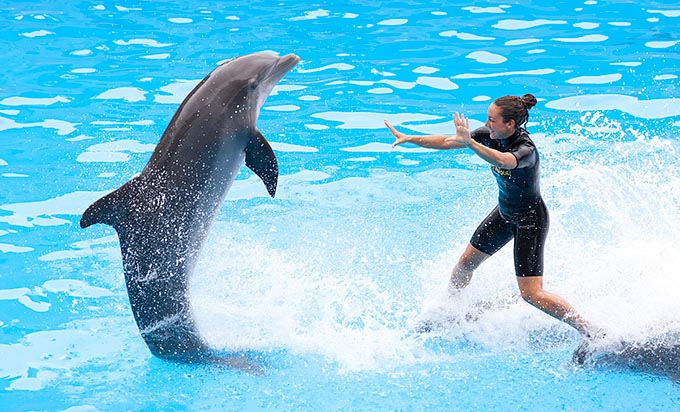
They are very intelligent. Here, the girl is carried by two dolphins, whilst a third one moves back upright © G. Mazza
As a matter of fact, these mammals nourish of molluscs, such as cephalopods and crustaceans, as well as of fishes, therefore of benthic animals and also of pelagic or bathy-pelagic ones.
Ethology-Reproductive Biology
It is an animal characterized by complex social modules, still little known. Also the reproductive behaviour is influenced by factor depending on the individual (age, degree of socialization) and on the environmental situation (geographic area, climate, availability of food).
The matings are usually very short lasting and may be preceded by complex phases of courting and competition between males, often the traces of the fights for a female are shown, under the form of marks and scars, on the skin of the males. In general, the delphinids, and therefore also the common bottlenose dolphin, couple belly to belly and this for a very short time. The male penetrates the female vagina with a penis, whose testicles are placed in the abdomen in a ventral position with respect to the kidneys.
The female has a vagina continuing in the uterus, subdivided in two lateral branches, and at the end of these last stand the oviducts and finally the ovaries. The mammary glands are placed in two narrow cuts in order to avoid friction while swimming.
In order to determine the sex in the dolphins (whilst in the orcas the dorsal fin has sexual dimorphism), it is necessary to examine the belly to see the presence or absence of these cuts. The sexual maturity is reached by the females when 10 years old, and by the males when about 13. The gestation period lasts about 12 months; upon their birth, the calves are 0,85-1,22 m long.
A companion female assists always the female during the delivery and, in order to avoid that the small newborn, getting out by the tail, drowns during the delivery, and keeps ready to carry it to the surface and to stay close to it, during the first minutes of life, for getting it to breathe. The nursing lasts 12-18 months; the reproductive period along the European coasts takes place in summer, along Florida coast the same stands in spring and in autumn.
